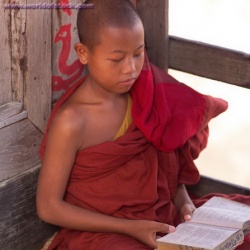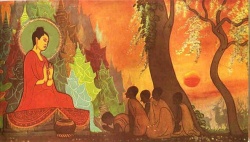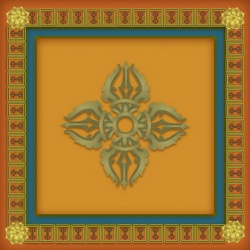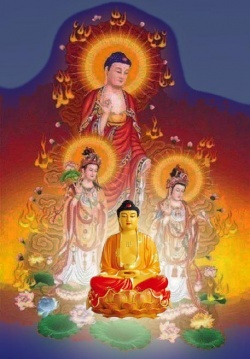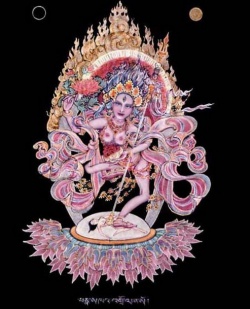On The Heart Sutra
By XVIIth Karmapa Urgyen Thinley Dorje
A Commentary
Some notes on the historical structure
and language of the heart sutra.
The Heart Sutra has been transmitted in a short form (about 14 slokas) and a longer form (about 22 slokas). The latter redaction, in 22 slokas, appears to be the more original (since it more neatly adheres to the earlier source texts, such as the Astasahasrika-prajnaparamita-sutra) and it is this text that we present herein.
There are at least 21 extant manuscript versions of the Heart Sutra: 12 Nepalese texts, seven Chinese, two Japanese, and one Tibetan version from the Kanjur. The Tibetan text we use is taken directly from the fresco in the Ge-gye Che-ma-ling (one of the temples of Samye Vihara) of circa 755-800 CE Under the patronage of the Sage Emperor Trisong Detsan, the Tibetan translator Bhikshu Rinchen De and the Indian Mahasamdhi-master Vimalamitra translated this text into Tibetan. Comparison between our fresco text and the Kanjur version shows no significant differences. The Tibetan version with an English translation made by Kyabje Palden Sherab Rimpoche, and his brother Tulku Tsewang, with the assistance of their disciples, has been published by Sky Dancer Press under the title of Ceaseless Echoes of the Great Silence (1993).
We are able to supply a redaction of the original Sanskrit text in Romanized script, as it emerges from a comparative study of the extant manuscripts juxtaposed along side the Tibetan. A fresh English translation has been supplied by us, with particular consideration given to the wording of the Sanskrit-text rather than the Tibetan; the Sanskrit being, of course, the more original. As a result of this comparison, we consider our redaction of the Sanskrit an improvement over Prof. Conze's initial work.
As pointed out by Conze, Kumarajiva's translation of the sutra into Chinese, by far the earliest version (c. 400 CE) of the Heart Sutra that we possess, is extremely important in tracing out the argument of the sutra as it would have appeared to its original compilers. The general agreement between Kumarajiva and Vimalamitra's text supports the thesis that the Tibetan represents a very early, unadulterated transmission. It will however be noted that there are three segments missing from the Tibetan that appear to have been present in the earliest Sanskrit version. These segments were undoubtedly dropped prior to Vimalamitra's era.
Now, Concerning The Translation:
In the title, the word hrdaya can be translated both 'heart' and 'essence', meaning that this sutra reveals the discrete essentials of the whole teaching of the practice of Prajñápáramitá. It is often called simply the Heart Sutra, but heart here means actually the "heart of Prajñápáramitá-practice."
The term Bhagavati means the Buddha; however, whereas 'Buddha' is a neuter term, the word Bhagavati is feminine. Bhagavat is the masculine. Bhagavat generally is translated 'Lord', meaning the Divine. Bhagavati has the same meaning in a feminine sense. Thus Transcendental Wisdom, the original nondual Gnosis, is personalized as the Absolute (buddha), the Divine (devadevata), and she is the Mother of all the Transcendental Ones (Tathagata), the womb of all Enlightened-beings.
'At one time' - This was when the historical Buddha Shakyamuni was at the Vulture's Peak near Rajagriha. From other sources we know that Shakyamuni traveled to Rajagriha from Vaisali, where he had successfully defended his teachings in debate against six leading teachers. He was reportedly 57 years old at that time. Therefore he was residing on the Vulture's Peak in his 57-58th year. Since the Wheel of the Dharma was set in motion in 533 BCE or 22 years prior to the Vaisali debate, we can calculate that the Lord was meditating on the Vulture's Peak circa 511-510 BCE
It should be noted that in the given context of the Sutra the traditional Bhiksu-samgha is contrasted with the traditional Bodhisattva-samgha. In this particular context the term Bhiksu-samgha means the community of monks and nuns in general, and the term Bodhisattva-samgha means the community of male and female laity. This follows in the tradition of early Mahayana iconography, where the former samgha is shown generally on the left of the painting and the latter on the right, with the Guru in the middle.
The term gambhira-avabhasa has connotations far more special than can be translated alone by the term 'Profound Radiance.' Avabhasa (Tib: sNang-ba) means "to shine forth" and/or "appearance", in the sense of the manner in which the Universe of phenomena "radiates forth as appearance." How does the Universe radiate forth as appearance? This was the meditation of the Buddha at that time.
The term 'profound' is used to signify the depth or ground of phenomenal existence. It is when abiding in contemplation at the substratum level (alaya) of this Universe, that mind grasps the way that phenomena radiate forth as Appearance, or in other words the manner in which the Universe comes into creation. The substratum level is the level at which phenomena comes into being. In other words it is the quantum level. It is thus that [the creation and nature of] phenomena are observed, and this is the meaning of the line: 'wherein [the creation and nature of] phenomena are examined.'
'Tena ca samayena' implies not the 'same time' but, according to the analysis our teacher Chogyam Trungpa, a coinciding or corresponding time period. Thus two time periods are being referred to, and it is said that these two time periods 'come together' much in the manner that two parallel universes might touch. In that time is relative, two time periods can be conceived as 'touching' each other.
It is through the anubhava or power of the Buddha that Shariputra is able to enquire of the cosmic-being (mahasattva, universal being) Bodhisattva Avalokitesvara concerning the non-dual Prajna-paramita. Might we translate anubhava as the 'inspiration' of the Buddha, in the sense that it was through such inspiration that Shariputra received Avalokiteshvara's revelation? The problem here is that the word 'inspiration' or 'revelation' is insufficient to also include the concept of a power (grace) that makes higher communication possible. What the text says is that it is through the Buddha's revelatory-power that Shariputra, a human being on our planet, was able to receive communication (inspiration) from the 'great-being' Avalokitesvara.
Avalokiteshvara's name means the lord (isvara) who has 'panoramic vision' (ava-lokitya, seeing the world-horizon). Note that in the text it says that Avalokitesvara was engaged in observing the practice of Transcendental Wisdom. Engaged (caramana—from the root car) here means 'coursing in', or 'in the flow', or 'journeying' through that observation. The word 'observing' is vyavalokayati, and there is a deliberate relationship between the usage of this term and the name of the Mahasattva himself. Coursing in the observation of the practice of Transcendental Wisdom (where the independent identity (svabhava) of aggregate-phenomena collapses into absoluteness, or zero-intensity) corresponds across the temporal world-horizon with the Buddha Shakyamuni's dwelling in the Profound Radiance samádhi. Herein too you must understand that 'contemplation' (samádhi) does not mean a state of intellectual enquiry or thought, but an infused condition of mystical absorption.
In the Tibetan version of this text the first Iha Shariputra of the Sanskrit text is missing, and yet it certainly must have been present in the original. Without it, the Sanskrit loses its poetic harmony and rhythm. The meaning of the text, however, is not altered by its absence. As the Tibetans were excruciatingly precise in their translations, these words must have been missing already by the time that Vimalamitra brought the text to Tibet circa 755 CE.
Note the variance between the word sunya (empty) and sunyata (emptiness). The text says Form is empty, Emptiness is form. In the next line we have Form is emptiness. This is a nice play of grammar and meaning. Many of the later renditions in Nepalese Sanskrit miss this distinction, which we also see as one of the signs of the authentic originality of the Tibetan text.
Laksana—an object is known by its characteristics. Without characteristics one object cannot be seen as separate or different from another object. The characteristics, for example, of a 'cup' is what defines a cup as different and distinct from a 'plate', and so forth. The inherent non-distinction (alaksana) of phenomena derives from the non-duality of the absolute state, the Supreme Reality (dharmata). Supreme Reality is ultimately the only reality, and this singular reality is Transcendental Wisdom. Another term would be Non-dual Gnosis (jnana advaya).
In this text the term jnana is used in the line Na jnanam, na praptirna-apraptih. In this line jnanam means 'knowledge'—particularly the knowledge acquired in the form of Enlightenment. In the Prajñápáramitá texts, we should understand that where jnana means 'knowledge' or 'insight' to be acquired, prajña (pra and jnana) means a 'superior knowledge' or 'an inherently existing, original Wisdom.' It is precisely because that Wisdom is already always present and complete, that there is nothing to acquire. Since the very beginning, no actual obscuration has occurred, and what is observed as 'ignorance' is merely a virtual obscuration. Hence in Mahasamdhi we have the doctrine of "Pure (Tib: kadag) from the Beginning."
Prapti is distinctly a term from the metaphysics of the Sarvastivada school. Vimalamitra was ordained in the Sarvastivada school (as distinct, for example, from the Abbot Shantaraksita who belonged to the Mulasarvastivada school) and this may be seen as one reason for the originality and lack of adulteration present in the Tibetan version of the Heart Sutra. Texts undergo change chiefly when being translated from one language to another, or when being copied, or when through age fragments become lost. Our text was undoubtedly composed in Sanskrit under the auspices of the Sarvastivada school. Other than possible scribal error, it would have been transmitted without alteration by the members of that school. Thus was it brought intact to Tibet. In other words, we are dealing with a text that has been passed down in a single line of continuity from its inception, with the least possible alteration. To explore the meaning of prapti and aprapti one should immerse oneself in the Abhidharmakosa-bhasyam of Vasubandhu, which is our most authoritative commentary on the metaphysical language of the Sarvastivada.
There are many small additions in subsequent versions of the Heart Sutra. Where, for example, our text declares that there is "no ignorance (avidya), no extinction of ignorance" several later editions add further that there is "no vidya (Tib: rig-pa)" either—a single interpolation with tremendous ramifications. In the intellectual milieu of the Mahasamdhiyogacara tradition this statement would be impossible. Historically speaking, we may draw the conclusion that nothing like this statement could have existed in the original document. We should also point out that this line, na vidya na vidyaksayo, is not to be found in Kumarajiva's translation.
Conze points out that in virtually all the later texts in place of cittalambana we have instead cittavarana—'mental-hindrances' (i.e., vices), instead of the original 'mental-objects' (i.e., objects of consciousness). In this regard again our Sanskrit shows an older derivation. Also 'mental-objects' makes better sense in the context.
Note that the term Tadyatha is retained in the Tibetan version of the mantra, whereas in the Sanskrit it is part of the sentence leading into the mantra. This is because the word tadyatha means "recite as follows: " we have adhered to the Sanskrit in this instance, with the result that in this instance our English translation is more accurate than the old Tibetan.
We also want to draw your attention to the word Arhadhih (confirming) which is missing in the Tibetan. It may well have been absent in the original text, but it is found in all the Sanskrit versions and must have been either included at a very early date or original with the text. It seems to give greater sense to the sentence and appears essential in the given context.
Likewise in the next line we find nothing that corresponds to the Sanskrit Te Ca Bhiksavas Ca Bodhisattvah, and yet the Sanskrit does seem to be an improved version. Whether this line is an addition to the text, or something that was dropped by error, we cannot ascertain. Anyone with an appreciation for the harmony of the text as a whole, would advocate that in any case it should be retained.
These are the points and issues of translation, which in particular should be noted when beginning a study of the Heart Sutra. May the blessing and insight of this Sutra be of benefit to each of you.
1. Conze, The Composition of the Astasahasrika Prajnaparamita, Bulletin of the London School of Oriental and African Studies, 14, 1952, pp. 251-62.
2. See Obermiller, Prajnaparamita in Tibetan Buddhism, Delhi 1988. p.6
3. Conze, The Perfection of Wisdom in Eight Thousand Lines, Bolinas CA. 1973
4. Conze, The Perfection of Wisdom in Eight Thousand Lines, Bolinas CA. 1975
5. Conze, The Prajnaparamita-hrdaya Sutra, Journal of the Royal Asiatic Soc., 1948, pp. 33-51
6. A. K. Warder, Indian Buddhism, Delhi, 1970
